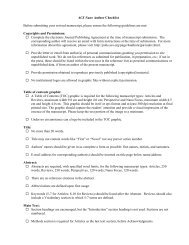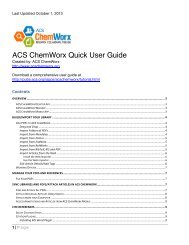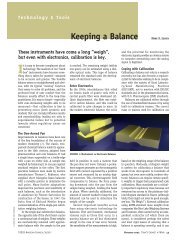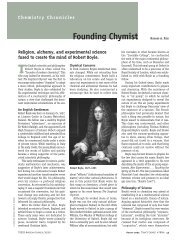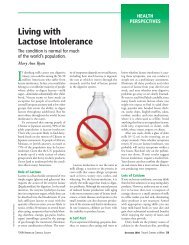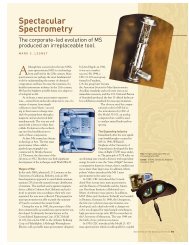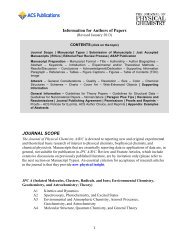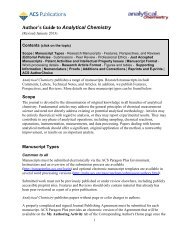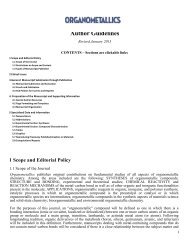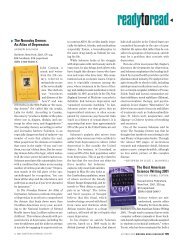Thermo Data on the Web - American Chemical Society Publications
Thermo Data on the Web - American Chemical Society Publications
Thermo Data on the Web - American Chemical Society Publications
You also want an ePaper? Increase the reach of your titles
YUMPU automatically turns print PDFs into web optimized ePapers that Google loves.
<str<strong>on</strong>g>Thermo</str<strong>on</strong>g> <str<strong>on</strong>g>Data</str<strong>on</strong>g> <strong>on</strong> <strong>the</strong> <strong>Web</strong><br />
<str<strong>on</strong>g>Thermo</str<strong>on</strong>g>dynamic databases were <strong>on</strong>ce piles<br />
of books but are now accessible <strong>on</strong>line.<br />
Stephen R. Heller<br />
Even if you passed physical chemistry<br />
as an undergraduate, you may well<br />
have struggled with obtaining data<br />
such as Gibbs free energy, entropy, and<br />
enthalpy for <strong>the</strong>rmodynamic equati<strong>on</strong>s.<br />
For years, those who needed <strong>the</strong>se values<br />
had no choice but to look <strong>the</strong>m up in<br />
<strong>on</strong>e of <strong>the</strong> numerous chemical data handbooks.<br />
Today, <strong>the</strong>re is a better place to find<br />
<strong>the</strong>rmodynamic data: <strong>the</strong> <strong>Web</strong>. Dozens of<br />
sources of <strong>the</strong>rmo data are available <strong>on</strong> <strong>the</strong><br />
<strong>Web</strong>. The University of Illinois at Chicago<br />
has an excellent webpage with links to<br />
over 100 data and property calculati<strong>on</strong><br />
websites (http://tigger.uic.edu/~mansoori/<br />
<str<strong>on</strong>g>Thermo</str<strong>on</strong>g>dynamic.<str<strong>on</strong>g>Data</str<strong>on</strong>g>.and.Property_html).<br />
This article will cover just a few of <strong>the</strong><br />
major sites, both free and paid, that are<br />
now available. These sites include <strong>the</strong> NIST<br />
Chemistry <strong>Web</strong>Book (http://webbook.nist.<br />
gov), DIPPR (www.aiche.org/dippr),<br />
DECHEMA (www.dechema.de/f-infsys-e.<br />
htm), and FIZ-Berlin Info<strong>the</strong>rm (www.<br />
fiz-chemie.de/info<strong>the</strong>rm/servlet/info<strong>the</strong>rmSearch).<br />
According to <strong>the</strong> Nati<strong>on</strong>al Institute of<br />
Standards and Technology (NIST), usage<br />
of <strong>the</strong> <strong>Web</strong>Book database and search system<br />
exceeds 20,000 users per week, with over<br />
600,000 different IP addresses per year<br />
accessing just <strong>the</strong> <strong>Web</strong>Book. Although <strong>the</strong><br />
<strong>Web</strong>Book covers a wide variety of subjects,<br />
its core is <strong>the</strong>rmochemical and <strong>the</strong>rmophysical<br />
data.<br />
What are people doing with this informati<strong>on</strong>?<br />
In <strong>the</strong> chemical process industry,<br />
it would be difficult to build an efficient<br />
and cost-effective plant for producing a<br />
chemical without good, high-quality <strong>the</strong>rmophysical<br />
and <strong>the</strong>rmochemical properties.<br />
In <strong>the</strong> field of petroleum and bulk<br />
chemicals, where profit margins are slim,<br />
good data can be <strong>the</strong> difference between<br />
a well-run, profitable operati<strong>on</strong> and <strong>on</strong>e<br />
in <strong>the</strong> red. This informati<strong>on</strong> is needed for<br />
scale-up testing of large batches of chemicals.<br />
<str<strong>on</strong>g>Thermo</str<strong>on</strong>g>dynamics data are used to<br />
© 2004 AMERICAN CHEMICAL SOCIETY<br />
design systems to minimize heat losses.<br />
They also help in <strong>the</strong> design of distillati<strong>on</strong><br />
columns. In <strong>the</strong>se times, when every<strong>on</strong>e<br />
is cost-sensitive, good <strong>the</strong>rmo data will<br />
improve both <strong>the</strong> quality of producti<strong>on</strong><br />
and <strong>the</strong> quality of <strong>the</strong> product, leading to<br />
better profit margins.<br />
NIST Chemistry <strong>Web</strong>Book<br />
The Chemistry <strong>Web</strong>Book is by far <strong>the</strong> most<br />
used source of <strong>the</strong>rmodynamics data. At<br />
present, all <strong>the</strong> informati<strong>on</strong> in <strong>the</strong><br />
<strong>Web</strong>Book is free, which, in additi<strong>on</strong> to <strong>the</strong><br />
high quality of <strong>the</strong> evaluated data, is probably<br />
<strong>the</strong> major reas<strong>on</strong> for its high and widespread<br />
use. It c<strong>on</strong>tains data <strong>on</strong> over 48,000<br />
chemicals, including <strong>the</strong>rmochemical data<br />
for more than 7000 organic and small inorganic<br />
compounds, such as enthalpy of<br />
formati<strong>on</strong>, enthalpy of combusti<strong>on</strong>, heat<br />
capacity, entropy, phase transiti<strong>on</strong> enthalpies<br />
and temperatures, and vapor pressure. In<br />
additi<strong>on</strong>, <strong>the</strong>re are reacti<strong>on</strong> <strong>the</strong>rmochemistry<br />
data for over 8000 reacti<strong>on</strong>s <strong>on</strong><br />
enthalpy of reacti<strong>on</strong> and free energy of<br />
reacti<strong>on</strong>.<br />
The <strong>Web</strong>Book has numerous easy-touse<br />
search capabilities, including chemical<br />
name, formula, molecular weight, CAS<br />
Registry Number, author, structure,<br />
substructure, and reacti<strong>on</strong>.<br />
DIPPR<br />
The Design Institute for Physical Properties<br />
(DIPPR) is a part of <strong>the</strong> <strong>American</strong><br />
SYSTEMS &<br />
DATA HANDLING<br />
Institute of <strong>Chemical</strong> Engineers. With<br />
funding from <strong>the</strong> chemical industry,<br />
DIPPR has undertaken 7 major projects<br />
over <strong>the</strong> past 2 decades, and <strong>on</strong>e of <strong>the</strong>m,<br />
a database of 1743 chemicals, has become<br />
<strong>the</strong> industry standard for <strong>the</strong> physical properties<br />
of pure comp<strong>on</strong>ents.<br />
Figure 1. NIST <strong>Web</strong>Book Antoine equati<strong>on</strong> data for benzoic acid. (Courtesy of NIST.)<br />
The DIPPR database c<strong>on</strong>sists of experimental<br />
data, estimated values where necessary,<br />
temperature-dependent correlati<strong>on</strong><br />
coefficients, references, notes, quality codes,<br />
and o<strong>the</strong>r informati<strong>on</strong> required for proper<br />
use of <strong>the</strong> DIPPR database in computeraccessible<br />
form, toge<strong>the</strong>r with software for<br />
searching, accessing, and using <strong>the</strong> data<br />
and accompanying informati<strong>on</strong>.<br />
The database also includes source data<br />
values and references, data quality codes,<br />
and background informati<strong>on</strong>, such as<br />
molecular structure, syn<strong>on</strong>yms, hazard<br />
properties, miscellaneous properties, notes,<br />
and explanati<strong>on</strong>s. It now c<strong>on</strong>tains data for<br />
29 fixed-value properties and 15 temperature-dependent<br />
properties. When <strong>the</strong><br />
project is completed, data for approximately<br />
1811 industrially important<br />
compounds will be included. As far as<br />
possible, values of all <strong>the</strong>se properties are<br />
entered for each chemical. If experimental<br />
data are not available, values are esti-<br />
KEY TERMS: data handling, materials/<br />
nanotech<br />
APRIL 2004 TODAY’S CHEMIST AT WORK 17
SYSTEMS & DATA HANDLING<br />
Figure 2. DECHEMA Antoine equati<strong>on</strong> data for benzoic acid. (Courtesy of DECHEMA.)<br />
mated when possible. Temperaturedependent<br />
correlati<strong>on</strong> coefficients, applicable<br />
upper and lower temperature limits,<br />
and values computed at <strong>the</strong>se limits are<br />
included for temperature-dependent properties.<br />
Fundamental SI units are used.<br />
The DIPPR database is available <strong>on</strong>line<br />
via <strong>the</strong> <strong>Chemical</strong> Abstracts Service STN<br />
computer network (www.cas.org). It is also<br />
available in a limited form at Brigham<br />
Young University (BYU). If you are a<br />
student or employee of an educati<strong>on</strong>al<br />
instituti<strong>on</strong> and would like access to <strong>the</strong><br />
DIPPR 801 student database, go to http://<br />
dippr.byu.edu/students/chemsearch.asp.<br />
DECHEMA<br />
The <strong>Society</strong> for <strong>Chemical</strong> Engineering and<br />
Biotechnology (DECHEMA) is a n<strong>on</strong>profit<br />
scientific and technical society based in<br />
Frankfurt/Main, Germany. It was founded<br />
in 1926. One of its main activities has<br />
been <strong>the</strong> creati<strong>on</strong> and disseminati<strong>on</strong> of <strong>the</strong><br />
DETHERM database and search system.<br />
The DETHERM database provides<br />
<strong>the</strong>rmophysical property data for about<br />
21,000 pure compounds and 101,000<br />
mixtures. These data are indispensable for<br />
<strong>the</strong> design of apparatus and chemical<br />
producti<strong>on</strong> facilities.<br />
DETHERM c<strong>on</strong>tains literature values<br />
toge<strong>the</strong>r with bibliographical informati<strong>on</strong>,<br />
descriptors, and abstracts. At this writing,<br />
4.2 milli<strong>on</strong> data sets are stored that c<strong>on</strong>tain<br />
<strong>the</strong> following properties: phase equilibrium<br />
data, vapor pressures, critical data, <strong>the</strong>rmodynamic<br />
properties, transport properties,<br />
surface tensi<strong>on</strong>s, and electrolyte data.<br />
Info<strong>the</strong>rm—FIZ-Berlin<br />
The last database and search system to be<br />
described here is <strong>the</strong> Info<strong>the</strong>rm system<br />
from FIZ-Berlin—<strong>the</strong> Chemistry Informati<strong>on</strong><br />
Centre (Fachinformati<strong>on</strong>szentrum<br />
Chemie, FIZ Chemie Berlin). Launched<br />
in late 2003, <strong>the</strong> Info<strong>the</strong>rm database of<br />
<strong>the</strong> <strong>the</strong>rmophysical properties of substances<br />
is written in Extensible Markup Language<br />
(XML), allowing both human users and<br />
computers to read and understand <strong>the</strong><br />
informati<strong>on</strong>. By making Info<strong>the</strong>rm available<br />
via <strong>the</strong> <strong>Web</strong>, FIZ Chemie Berlin hopes<br />
to target those chemical engineering offices<br />
and companies that are increasingly using<br />
<strong>the</strong> Internet to meet <strong>the</strong>ir informati<strong>on</strong><br />
requirements. The integrati<strong>on</strong> of <strong>the</strong> database<br />
in company intranets is simple using<br />
XML technology.<br />
The high-quality Info<strong>the</strong>rm database<br />
delivers data <strong>on</strong> pure compounds and <strong>on</strong><br />
Figure 3. Info<strong>the</strong>rm Antoine equati<strong>on</strong> data: complete output for benzoic acid. (Courtesy of FIZ-Berlin.)<br />
mixtures, such as pressure-volume-temperature<br />
(PVT) properties, phase equilibria,<br />
transport and surface properties, calorific<br />
properties, and solid–liquid equilibria. The<br />
complete database c<strong>on</strong>tains more than<br />
90,000 data records for mixtures and about<br />
199,000 for pure substances. The first<br />
release in late 2003 c<strong>on</strong>tained more than<br />
80,000 data sets <strong>on</strong> mixtures and more<br />
than 60,000 <strong>on</strong> pure compounds. Each<br />
piece of data may be accessed via <strong>the</strong> chemical<br />
name, trivial name, molecular formula,<br />
or CAS Registry Number. The data<br />
originate from journal articles, handbooks,<br />
and data collecti<strong>on</strong>s that are evaluated by<br />
FIZ Chemie Berlin and cover <strong>the</strong> period<br />
from 1985 until <strong>the</strong> present. The database<br />
is updated m<strong>on</strong>thly. It provides informati<strong>on</strong><br />
<strong>on</strong> <strong>the</strong> <strong>the</strong>rmophysical properties of<br />
6300 pure chemical compounds and<br />
23,000 mixtures, al<strong>on</strong>g with full bibliographic<br />
data. Some 150,000 tables c<strong>on</strong>tain<br />
PVT properties, phase equilibria, transport<br />
and surface properties, calorific properties,<br />
and acoustic and optical properties.<br />
Searching <strong>the</strong> database and <strong>the</strong><br />
“preview” display format of results is free<br />
of charge. This policy is somewhere<br />
between <strong>the</strong> search policy for <strong>the</strong> NIST<br />
data, which are available at no cost, and<br />
18 TODAY’S CHEMIST AT WORK APRIL 2004 www.tcaw<strong>on</strong>line.org
SYSTEMS & DATA HANDLING<br />
<strong>the</strong> DECHEMA data, which are all for a<br />
fee. The website does let you know when<br />
<strong>the</strong> informati<strong>on</strong> is available at no cost.<br />
Info<strong>the</strong>rm offers pay-per-view access or<br />
full access to all documents <strong>on</strong> a license<br />
basis. Pay-per-view users can purchase full<br />
access to an individual document from<br />
<strong>the</strong> free-preview format. For c<strong>on</strong>siderable<br />
flexibility, all purchased documents can<br />
be downloaded in several data formats.<br />
(Note: The CSV (comma-separated value)<br />
download exports <strong>on</strong>ly <strong>the</strong> data in a<br />
spreadsheet format, such as MS Excel.)<br />
Opti<strong>on</strong>ally, <strong>the</strong> user can store all documents<br />
in <strong>the</strong> “my info<strong>the</strong>rm” secti<strong>on</strong> by<br />
selecting from <strong>the</strong> hit list. These documents<br />
will be available in future sessi<strong>on</strong>s.<br />
Besides licensing <strong>the</strong> entire database,<br />
customers can purchase prepaid packages,<br />
which can be transformed into an unlimited<br />
license if <strong>the</strong> usage exceeds <strong>the</strong> respective<br />
license fee.<br />
Antoine Equati<strong>on</strong> <str<strong>on</strong>g>Data</str<strong>on</strong>g><br />
An example of a search in three of <strong>the</strong>se<br />
systems and <strong>the</strong> resulting outputs is shown<br />
in Figures 1–3. In <strong>the</strong> examples, <strong>the</strong> search<br />
was for Antoine equati<strong>on</strong> data for benzoic<br />
acid to estimate <strong>the</strong> vapor pressure at different<br />
temperatures.<br />
Chemists often use <strong>the</strong> Clausius–Clapeyr<strong>on</strong><br />
equati<strong>on</strong> to estimate <strong>the</strong> vapor pressure<br />
of pure liquids or solids, and it works<br />
well for most applicati<strong>on</strong>s. Several of <strong>the</strong><br />
assumpti<strong>on</strong>s made in <strong>the</strong> derivati<strong>on</strong> of<br />
<strong>the</strong> equati<strong>on</strong> fail at high pressure and near<br />
<strong>the</strong> critical point, giving inaccurate results.<br />
<strong>Chemical</strong> engineers often need more reliable<br />
vapor pressure estimates. The Antoine<br />
equati<strong>on</strong> is a simple three-parameter fit to<br />
experimental vapor pressures measured over<br />
a restricted temperature range:<br />
log P = A – B<br />
T + C<br />
where A, B, and C are Antoine coefficients<br />
that vary from substance to substance.<br />
Sublimati<strong>on</strong>s and vaporizati<strong>on</strong>s of <strong>the</strong> same<br />
substance have separate sets of Antoine<br />
coefficients, as do comp<strong>on</strong>ents in mixtures.<br />
The Antoine equati<strong>on</strong> is accurate to a<br />
few percent for most volatile substances<br />
(with vapor pressures over 10 Torr).<br />
The NIST <strong>Web</strong>Book results are shown<br />
in Figure 1, and all data from <strong>the</strong><br />
DECHEMA database are available for a<br />
fee, which is shown in each of <strong>the</strong> five hits<br />
in Figure 2.<br />
The search in <strong>the</strong> Info<strong>the</strong>rm system<br />
starts out with <strong>the</strong> webpage displaying <strong>the</strong><br />
search opti<strong>on</strong>s, including search by name;<br />
formula; CAS Registry Number; type of<br />
data you want to search for (<strong>the</strong> pulldown<br />
menus list dozens of properties, as in <strong>the</strong><br />
DECHEMA search system); a bibliography<br />
search for author, title, and so <strong>on</strong>; and<br />
type of system (pure, binary, and <strong>the</strong>n up<br />
to denary).<br />
Figure 3 shows <strong>the</strong> detailed output from<br />
Info<strong>the</strong>rm. This example is from a record<br />
that is available at no cost.<br />
In summary, <strong>the</strong>rmodynamics data, an<br />
important need for industrial research, is<br />
now widely available via <strong>the</strong> <strong>Web</strong>. The examples<br />
shown here are just a few of <strong>the</strong> many<br />
sources of this informati<strong>on</strong> and again prove<br />
why <strong>the</strong> <strong>Web</strong> is such a w<strong>on</strong>derful resource<br />
in making it easier for today’s chemists to<br />
do <strong>the</strong>ir work quickly and efficiently.<br />
Stephen R. Heller is a freelance writer based in Silver<br />
Spring, MD. ◆<br />
20 TODAY’S CHEMIST AT WORK APRIL 2004 www.tcaw<strong>on</strong>line.org



